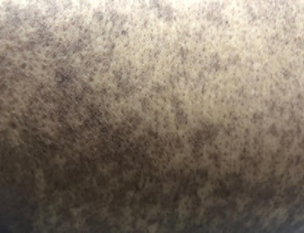Abstract
Nivolumab, a PDL1 antagonist is an immunotherapeutic agent that is effectively used for the second-line treatment of advanced or metastatic lung carcinoma. Although Nivolumab improved the overall survival of patients with non-small cell lung cancers in the setting, it is known to result in adverse events called immune-related adverse events (irAEs) like colitis, pneumonitis, skin disorders, and myasthenia gravis. The majority of cutaneous reactions associated with Nivolumab therapy are Grade 1or Grade 2 but Grade 3 skin reactions are very rare. The grade 3 skin reactions are macules or papules covering >30% of body surface area with moderate or severe symptoms (pruritis, burning, tightness) often impacting the patient’s quality of life. This is a case of a 78-year-old man with Stage 4 metastatic squamous cell lung carcinoma (SqCC), treated with Nivolumab following disease progression after 4 cycles of Paclitaxel / Carboplatin chemotherapy. The patient developed mild hyperpigmentation over the upper and lower limbs after eight cycles of Nivolumab, which progressed to Grade 3 skin reaction with intense pruritis after the eleventh cycle. He was treated with systemic steroids and Nivolumab was discontinued after which the patient’s condition improved. Health care professionals should be aware of the immunological side effect profile of Nivolumab. Close monitoring, periodic dermatological evaluation, and appropriate clinical management is recommended in patients on immunotherapy.
Full text article
Authors

This work is licensed under a Creative Commons Attribution-NonCommercial-NoDerivatives 4.0 International License.

